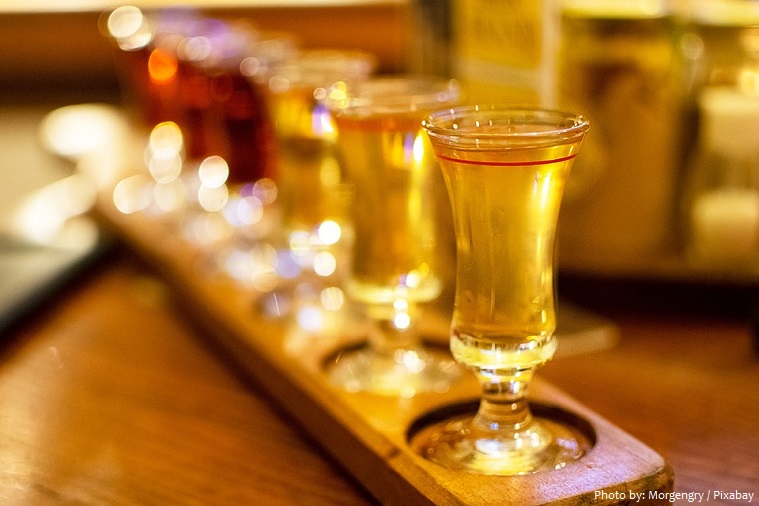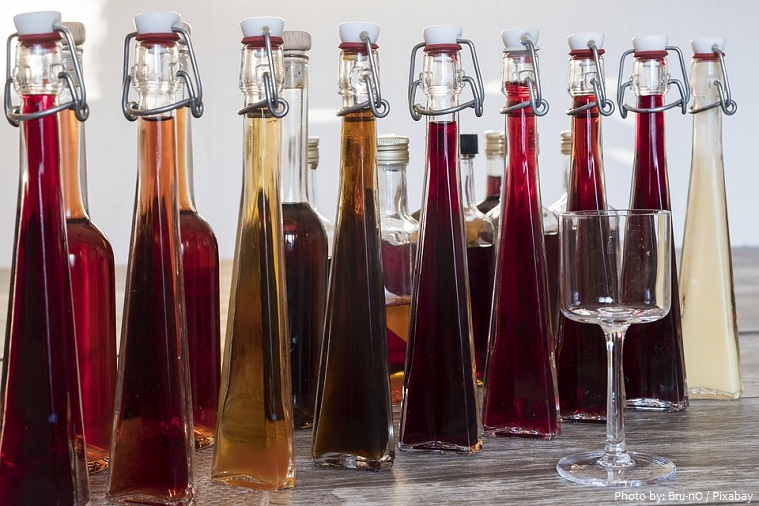
A liqueur is an alcoholic drink composed of distilled spirits and additional flavorings such as sugar, fruits, herbs, and spices.
Liqueurs are produced by combining a base spirit, usually brandy, with fruits or herbs and are sweetened by the addition of a sugar syrup composing more than 2 1/2 percent of the total beverage by volume.
Fruit liqueurs are produced by the infusion method, in which fruit is steeped in the spirit, which absorbs aroma, flavour, and colour. Plant liqueurs, naturally colourless, are produced by either percolation or
distillation.

Brand names like, Benedictine, Campari, Cointreau, and Drambuie are common sights in many bars. Some of these have proprietary recipes with distinct, unique flavor profiles that cannot easily be substituted.
There are a number of names for styles of liqueur as well. Absinthe, creme de cassis, and peach schnapps are just a few examples, often produced by multiple brands. A number of these are also ideal candidates for homemade liqueurs, which are quite fun to make and add to your bar as well.
Often served with or after dessert, they are typically heavily sweetened and un-aged beyond a resting period during production, when necessary, for their flavors to mingle.

They have been called balms, crèmes, elixirs, and oils and have been used over the centuries as medicines and tonics, love potions, and aphrodisiacs.
The word “liqueur” is derived from the Latin liquefacere, meaning “to make liquid.”
Recipes for liqueurs have been found in Egyptian tombs and ancient Greek scrolls, but it is primarily the monks of Europe, particularly Italian monks during the 13th Century, who developed the liqueur as a way to infuse herbs for medicinal use.
One of the most famous liqueurs to be developed by European monks is Green Chartreuse, which was developed by monks from the Carthusian order in the French Alps. It contains over 130 herbs and spices, some of which are rare, and only three monks know the full recipe, and which herbs produce its unique, natural colour.

As the trade routes opened, the variety of spices and other ingredients, such as ginger, orange and chocolate, made their way into liqueurs, and many households had their own distillery and recipes. Some were used for their anesthetic qualities and used by women during childbirth, while others were imbibed as a digestive aid. They also became fashionable. After Catherine De Medici wed Henry II of France, she introduced the culture of liqueur drinking to the French Court.
Today, they are produced the world over, commonly served neat, over ice, with coffee, in cocktails, and used in cooking.
Liqueurs, sweet in flavour and with ingredients promoting digestion, are popular after-dinner drinks. They may be served straight, poured over ice, or mixed in an endless variety of combinations that may include liquors, brandies, and cream. Liqueurs are also used as flavourings in various dessert dishes.

Absinthe is an anise-flavored liqueur that was originally 136 proof and was banned by law for many years in most countries. Absante, Pernod, and Herbsaint can be used to replace absinthe in cocktail recipes.
Amaretto is an almond-flavored liqueur made with apricot pits. It is one of the most popular liqueurs and is essential in a well-stocked bar. Amaretto is commonly paired with a coffee liqueur or used as a smooth, sweet liqueur in shooters.
Grand Marnier is a delicious example of an orange liqueur. It is an ingredient in classic cocktails such as the whiskey daisy and makes a flavorful addition to many recipes. It’s also a delight when sipped as a
nightcap in hot tea.
Jägermeister is a very popular herbal liqueur produced in Germany with a somewhat notorious reputation. It is often served in shooters but can also be enjoyed in fine cocktails.

Anise and Rakı liqueurs have the property of turning from transparent to cloudy when added to water: the oil of anise remains in solution in the presence of a high concentration of alcohol, but coalesces when the alcohol concentration is reduced; this is known as the ouzo effect.
The words “liqueur” and “liquor” are so similar that it is easy to confuse the two. Although both are distilled spirits that contain alcohol and are crucial ingredients when mixing cocktails, the liquids are not the same and the terms are not interchangeable.
Generally speaking, liquor is not sweet, while liqueurs are. However, many liquors are available in flavored forms, which just adds to the confusion. Liquors are the basis of a drink while liqueurs are mainly used as flavoring agents in mixed drinks (but many can also be enjoyed on their own).